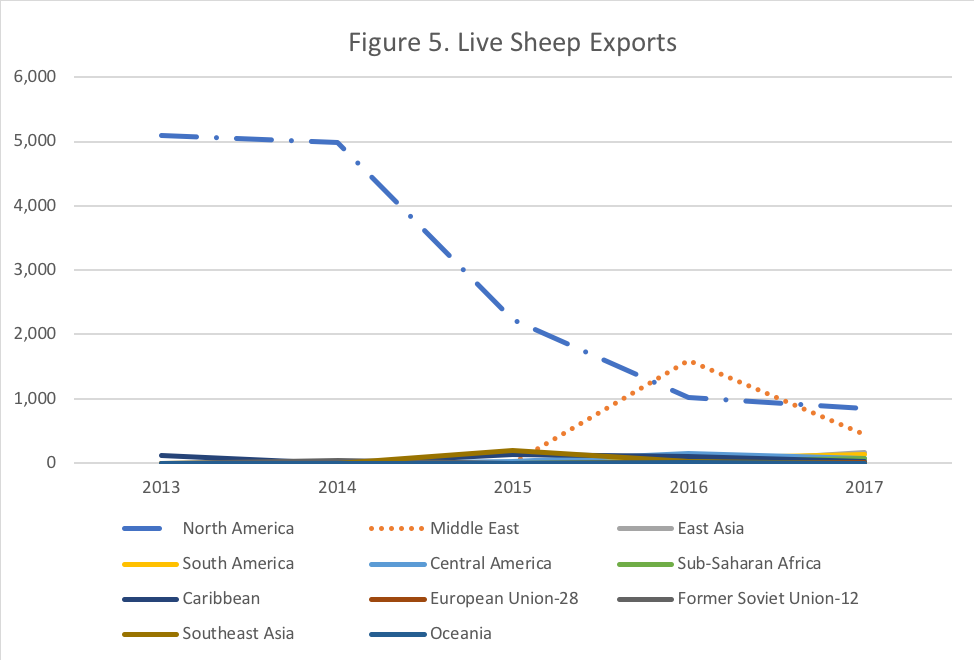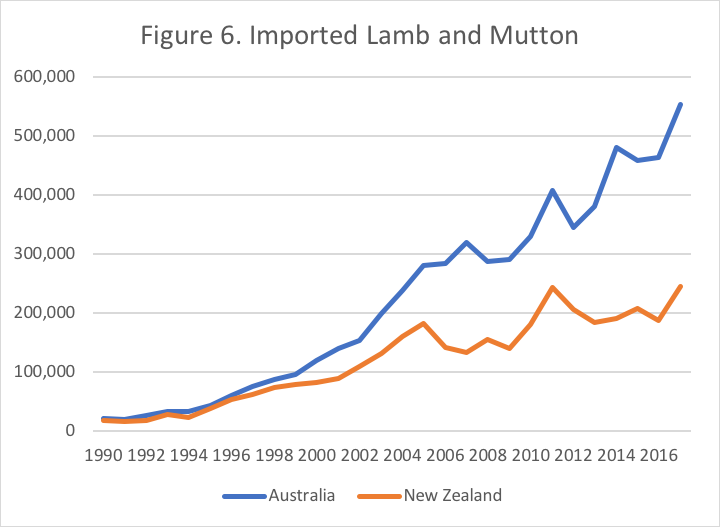A couple weeks ago I visited a friend’s sheep ranch in western Idaho for Fourth of July. This ranch raises Dorper sheep—a hair sheep that cannot be raised with wool sheep as the hair mixes into the wool sheep’s fleece and is difficult to remove. There are at least a couple advantages to the hair sheep: they do not need to be shorn, reducing labor demands, and they produce a milder flavor of meat, which many consumers prefer. A primary disadvantage is obviously that the sheep cannot be used for wool production. Demand for wool has decreased over the past several decades as more and more wool products have been replaced with synthetic materials. The price of wool is trending upwards now, but real prices are still much lower than they were in the 1950s when the U.S. military still demanded wool uniforms for soldiers in Korea (see Figure 1).

Source: Federal Reserve Bank of St. Louis. Federal Reserve Economic Data. https://fred.stlouisfed.org Accessed July 13, 2018
The number of wool operations located in Montana have declined since 1997, but they were up slightly in 2012 since the previous census in 2007 (see Figure 2). Unsurprisingly, wool and lamb and mutton production are highly correlated, and both have been declining since World War II (see Figure 3). (Lamb refers to meat from sheep usually younger than 14 months, and mutton refers to meat from older sheep).

Source: USDA NASS. Quick Stats. https://quickstats.nass.usda.gov/ Accessed July 13, 2018

Source: USDA NASS. Quick Stats. https://quickstats.nass.usda.gov/ Accessed July 13, 2018
Demand for lamb and mutton in the United States is primarily concentrated among ethnic minorities, and demand is higher during the Passover and Easter seasons. Most U.S. lamb and mutton production is consumed domestically. The U.S. exports some lamb and mutton to the Caribbean and European Union. For many years, the United States exported live sheep almost exclusively to Canada and Mexico (primarily to take advantage of additional processing facilities on the Canadian side of the border), but the United States has also exported to the Middle East in recent years (Figures 4 and 5). The United States imports relatively few live sheep, currently only from Canada.

Source: USDA Foreign Agricultural Service. Global Agricultural Trade System. https://apps.fas.usda.gov/Gats/default.aspx Accessed July 13, 2018

Source: USDA Foreign Agricultural Service. Global Agricultural Trade System. https://apps.fas.usda.gov/Gats/default.aspx Accessed July 13, 2018
The United States imports lamb and mutton from Australia and New Zealand, which have a comparative advantage in raising sheep due to their abundance of grazing pasture. Imports from Australia and New Zealand are rising, suggesting that U.S. sheep production is not sufficient to satisfy domestic demand (Figure 6).

Source: USDA Foreign Agricultural Service. Global Agricultural Trade System. https://apps.fas.usda.gov/Gats/default.aspx Accessed July 13, 2018
Some U.S. ranches raise sheep exclusively because they eat shrubs and noxious weeds that cattle will not, but there are still marketing opportunities for sheep products. Harnessing the appropriate markets is the challenge. Potential market expansion likely includes communities of ethnic minorities within the United States, export markets, and restaurants that are looking to expand their menus by providing different varieties and cuts of domestically produced meat. Companies like Duckworth have also created a niche market for American-made wool clothing. Experimentation in raising different breeds of sheep and grazing practices to impact the flavor of the meat may open up more diverse markets for sheep and lamb while there is also opportunity for producers that focus on creating high-quality wool products as well.
Additional Reading:
Hemphill, Peter. “1950s Wool Boom Still Surpasses Today’s Record Prices in Real Dollars.” The Weekly Times. June 6, 2018. https://www.weeklytimesnow.com.au/agribusiness/sheep/1950s-wool-boom-still-surpasses-todays-record-prices-in-real-dollars/news-story/1e4eb20ec34a9645033e08d137333642 Accessed July 13, 2018.
USDA. “Overview of the United States Sheep and Goat Industry.” August 9, 2011. http://usda.mannlib.cornell.edu/usda/current/ShpGtInd/ShpGtInd-08-09-2011.pdf Accessed July 13, 2018.

